A Search Engine Concept to Improve Food Traceability and Transparency: Preliminary Results
Abstract
:1. Introduction
2. Methodology
- To consider products of both vegetable (olive oil) and animal origin (milk and fishery products);
- To consider products of interest (e.g., economically important) in various European geographical areas (the Mediterranean area for olive oil, central Europe for milk, northern and Mediterranean area for fishery products);
- To consider products of different supply chains that allow for covering multiple issues and research questions such as nutrition claims (olive oil), the definition of geographical (milk and fishery products) and botanical (olive oil) origin and production sustainability (fishery products);
- The possibility to extend the case studies to further products obtained by their processing (e.g., dairy products).
- Sole supply chain—as representative of a marine wild-caught, medium size, and lean fish;
- Salmon supply chain—as representative of the aquaculture line, large size, and fatty fish;
- Anchovies supply chain—as representative of a marine wild-caught, small size, medium fat fish.
- Parameters of interest
- Parameters of influence
3. Results: Traceability Search Engine Concept
- (a)
- Type—defines the type of the resource;
- (b)
- Food group/matrix—describes a group of foods or a single food item;
- (c)
- Food supply chain—describes for each food group/matrix a separate chain of phases;
- (d)
- Country—defines the country of origin for the data or information of a resource;
- (e)
- Main aspects of food science used in this concept—tags are nutritional quality, safety, and authenticity/traceability (based on the outcome of the former section);
- (f)
- Research area—defines a comprehensive list of research aspects in food science which can change over time;
- (g)
- Target audience—defines different user groups such as primary producers, processors, distributors, retailers, consumers, researches, inspection and control agencies, certification bodies, authorities and policy makers;
- (h)
- Access mode—defines how a resource can be accessed, e.g., open access, restricted access or no access;
- (i)
- Year—defines the year of a resource;
- (j)
- Chemical substance—defines the list of nutrients, contaminants, and other chemical substances;
- (k)
- Parameter of interest—describes properties of foods that are of interest when it comes to traceability in combination with nutritional quality, safety and authenticity/transparency as presented in the former section. Parameters of influence are facts that have an influence on the measurement of the parameter of interest.
4. Conclusions
Author Contributions
Funding
Data Availability Statement
Conflicts of Interest
References
- Liu, Y.; Ma, X.; Shu, L.; Hancke, G.P.; Abu-Mahfouz, A.M. From Industry 4.0 to Agriculture 4.0: Current Status, Enabling Technologies, and Research Challenges. IEEE Trans. Ind. Inform. 2020, 17, 4322–4334. [Google Scholar] [CrossRef]
- Cox, M.; Ellsworth, D. Application-Controlled Demand Paging for Out-of-Core Visualization. In Proceedings. Visualization’97 (Cat. No. 97CB36155). In Proceedings of the Visualization’97 (Cat. No. 97CB36155), Phoenix, AZ, USA, 24–24 October 1997; pp. 235–244. [Google Scholar]
- Al-Mekhlal, M.; Ali Khwaja, A. A Synthesis of Big Data Definition and Characteristics. In Proceedings of the 2019 IEEE International Conference on Computational Science and Engineering (CSE) and IEEE International Conference on Embedded and Ubiquitous Computing (EUC), New York, NY, USA, 1–3 August 2009; pp. 314–322. [Google Scholar]
- Katal, A.; Wazid, M.; Goudar, R.H. Big Data: Issues, Challenges, Tools and Good Practices. In Proceedings of the 2013 Sixth International Conference on Contemporary Computing (IC3), Noida, India, 8–10 August 2013; pp. 404–409. [Google Scholar]
- Pollard, S.; Namazi, H.; Khaksar, R. Big Data Applications in Food Safety and Quality. In Encyclopedia of Food Chemistry; Elsevier: Amsterdam, The Netherlands, 2019; pp. 356–363. ISBN 978-0-12-814045-1. [Google Scholar]
- Buckley, J. How Is Big Data Going to Change the World? Available online: https://www.weforum.org/agenda/2015/12/how-is-big-data-going-to-change-the-world/ (accessed on 16 June 2021).
- Tao, D.; Yang, P.; Feng, H. Utilization of Text Mining as a Big Data Analysis Tool for Food Science and Nutrition. Compr. Rev. Food Sci. Food Saf. 2020, 19, 875–894. [Google Scholar] [CrossRef] [PubMed] [Green Version]
- Lacam, J.-S.; Salvetat, D. Big Data and Smart Data: Two Interdependent and Synergistic Digital Policies within a Virtuous Data Exploitation Loop. J. High Technol. Manag. Res. 2021, 32, 100406. [Google Scholar] [CrossRef]
- European Commission. Directorate General for Communications Networks, Content and Technology. In European Open Science Cloud: A New Paradigm for Innovation and Technology; European Commission: Luxemburg, 2019. [Google Scholar]
- Wilkinson, M.D.; Dumontier, M.; Aalbersberg, I.J.; Appleton, G.; Axton, M.; Baak, A.; Blomberg, N.; Boiten, J.-W.; da Silva Santos, L.B.; Bourne, P.E.; et al. The FAIR Guiding Principles for Scientific Data Management and Stewardship. Sci. Data 2016, 3, 160018. [Google Scholar] [CrossRef] [PubMed] [Green Version]
- European Commission Digital Economy and Society Index (DESI) 2021. Available online: https://digital-strategy.ec.europa.eu/en/library/digital-economy-and-society-index-desi-2021 (accessed on 28 January 2022).
- Viaene, J.; Meulenberg, M.T.G. Changing Agri-Food Systems in Western Countries: A Marketing Approach. In Innovation in Agri-Food Systems: Product Quality and Consumer Acceptance; Wageningen Academic Publishers: Wageningen, The Netherlands, 2005; ISBN 978-90-76998-65-7. [Google Scholar]
- Rao, S.K.; Prasad, R. Impact of 5G Technologies on Industry 4.0. Wirel. Pers Commun. 2018, 100, 145–159. [Google Scholar] [CrossRef]
- Wolfert, S.; Ge, L.; Verdouw, C.; Bogaardt, M.-J. Big Data in Smart Farming—A Review. Agric. Syst. 2017, 153, 69–80. [Google Scholar] [CrossRef]
- Nakamoto, S. Bitcoin P2P E-Cash Paper 2008. Available online: https://www.ussc.gov/sites/default/files/pdf/training/annual-national-training-seminar/2018/Emerging_Tech_Bitcoin_Crypto.pdf (accessed on 28 January 2022).
- Creydt, M.; Fischer, M. Blockchain and More—Algorithm Driven Food Traceability. Food Control 2019, 105, 45–51. [Google Scholar] [CrossRef]
- Kamilaris, A.; Fonts, A.; Prenafeta-Boldύ, F.X. The Rise of Blockchain Technology in Agriculture and Food Supply Chains. Trends Food Sci. Technol. 2019, 91, 640–652. [Google Scholar] [CrossRef] [Green Version]
- Leible, S.; Schlager, S.; Schubotz, M.; Gipp, B. A Review on Blockchain Technology and Blockchain Projects Fostering Open Science. Front. Blockchain 2019, 2, 16. [Google Scholar] [CrossRef]
- Casino, F.; Dasaklis, T.K.; Patsakis, C. A Systematic Literature Review of Blockchain-Based Applications: Current Status, Classification and Open Issues. Telemat. Inform. 2019, 36, 55–81. [Google Scholar] [CrossRef]
- Feng, H.; Wang, X.; Duan, Y.; Zhang, J.; Zhang, X. Applying Blockchain Technology to Improve Agri-Food Traceability: A Review of Development Methods, Benefits and Challenges. J. Clean. Prod. 2020, 260, 121031. [Google Scholar] [CrossRef]
- Serazetdinova, L.; Garratt, J.; Baylis, A.; Stergiadis, S.; Collison, M.; Davis, S. How Should We Turn Data into Decisions in AgriFood? J. Sci. Food Agric. 2019, 99, 3213–3219. [Google Scholar] [CrossRef] [PubMed]
- FAO. WHO FAO’s Strategy for a Food Chain Approach to Food Safety and Quality: A Framework Document for the Development of Future Strategic Direction. Available online: http://www.fao.org/3/y8350e/y8350e.htm (accessed on 24 June 2021).
- Stenmarck, Å.; Jensen, C.; Quested, T.; Moates, G.; Buksti, M.; Cseh, B.; Juul, S.; Parry, A.; Politano, A.; Redlingshofer, B.; et al. Estimates of European Food Waste Levels; EU FUSIONS: Stockholm, Sweden, 2016; ISBN 978-91-88319-01-2. [Google Scholar]
- World Health Organization. WHO Estimates of the Global Burden of Foodborne Diseases; World Health Organization, Ed.; World Health Organization: Geneva, Switzerland, 2015; ISBN 978-92-4-156516-5. Available online: https://www.eu-fusions.org/phocadownload/Publications/Estimates%20of%20European%20food%20waste%20levels.pdf (accessed on 28 January 2022).
- Pizzuti, T.; Mirabelli, G. The Global Track&Trace System for Food: General Framework and Functioning Principles. J. Food Eng. 2015, 159, 16–35. [Google Scholar] [CrossRef]
- Casino, F.; Kanakaris, V.; Dasaklis, T.K.; Moschuris, S.; Rachaniotis, N.P. Modeling Food Supply Chain Traceability Based on Blockchain Technology. IFAC-PapersOnLine 2019, 52, 2728–2733. [Google Scholar] [CrossRef]
- Rychlik, M.; Zappa, G.; Añorga, L.; Belc, N.; Castanheira, I.; Donard, O.F.X.; Kouřimská, L.; Ogrinc, N.; Ocké, M.C.; Presser, K.; et al. Ensuring Food Integrity by Metrology and FAIR Data Principles. Front. Chem. 2018, 6, 49. [Google Scholar] [CrossRef] [PubMed] [Green Version]
- Palocci, C.; Zoani, C. Data Sharing to Improve Food Supply Chain Management. In The Book of Abstracts of the 5th International Conference on Metrology in Food and Nutrition—IMEKOFOODS 5; Czech University of Life Sciences Prague: Prague, Czech Republic, 2020; pp. 118–119. ISBN 978-80-213-3036-8. [Google Scholar]
- European Parliament; Council of the European Union Regulation (EU). No. 1308/2013 of the European Parliament and of the Council of 17 December 2013 Establishing a Common Organisation of the Markets in Agricultural Products and Repealing Council Regulations (EEC) No. 922/72, (EEC) No. 234/79, (EC) No. 1037/2001 and (EC) No. 1234/2007. (Consolidated Version 2021). Available online: https://eur-lex.europa.eu/legal-content/EN/TXT/?uri=CELEX%3A02013R1308-20211207 (accessed on 28 January 2022).
- European Parliament; Council of the European Union Regulation (EC). No 853/2004 of the European Parliament and of the Council of 29 April 2004 Laying down Specific Hygiene Rules for Food of Animal Origin. (Consolidated Version 2021). Available online: https://eur-lex.europa.eu/legal-content/SV/TXT/?uri=CELEX:02004R0853-20211028 (accessed on 28 January 2022).
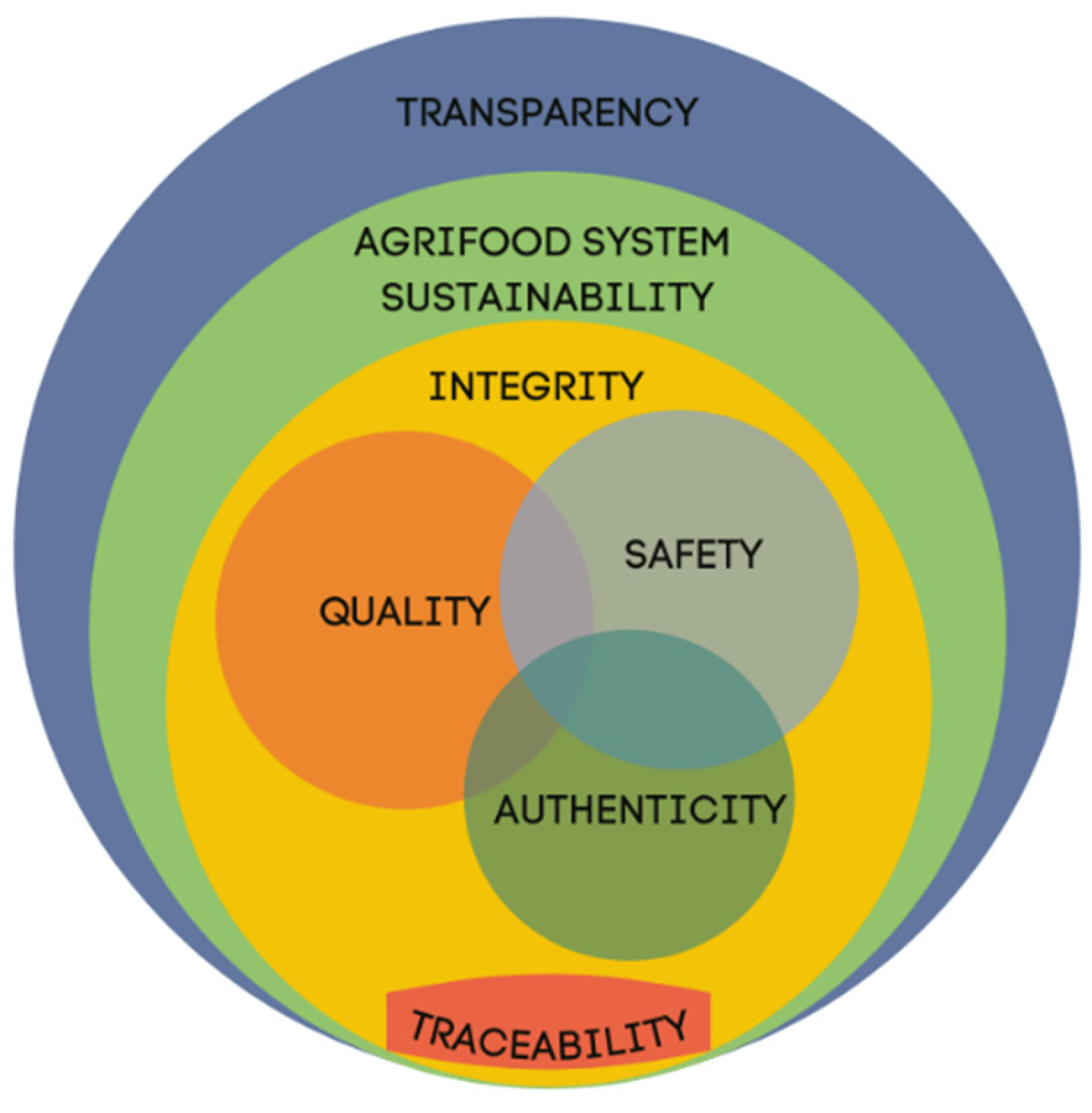
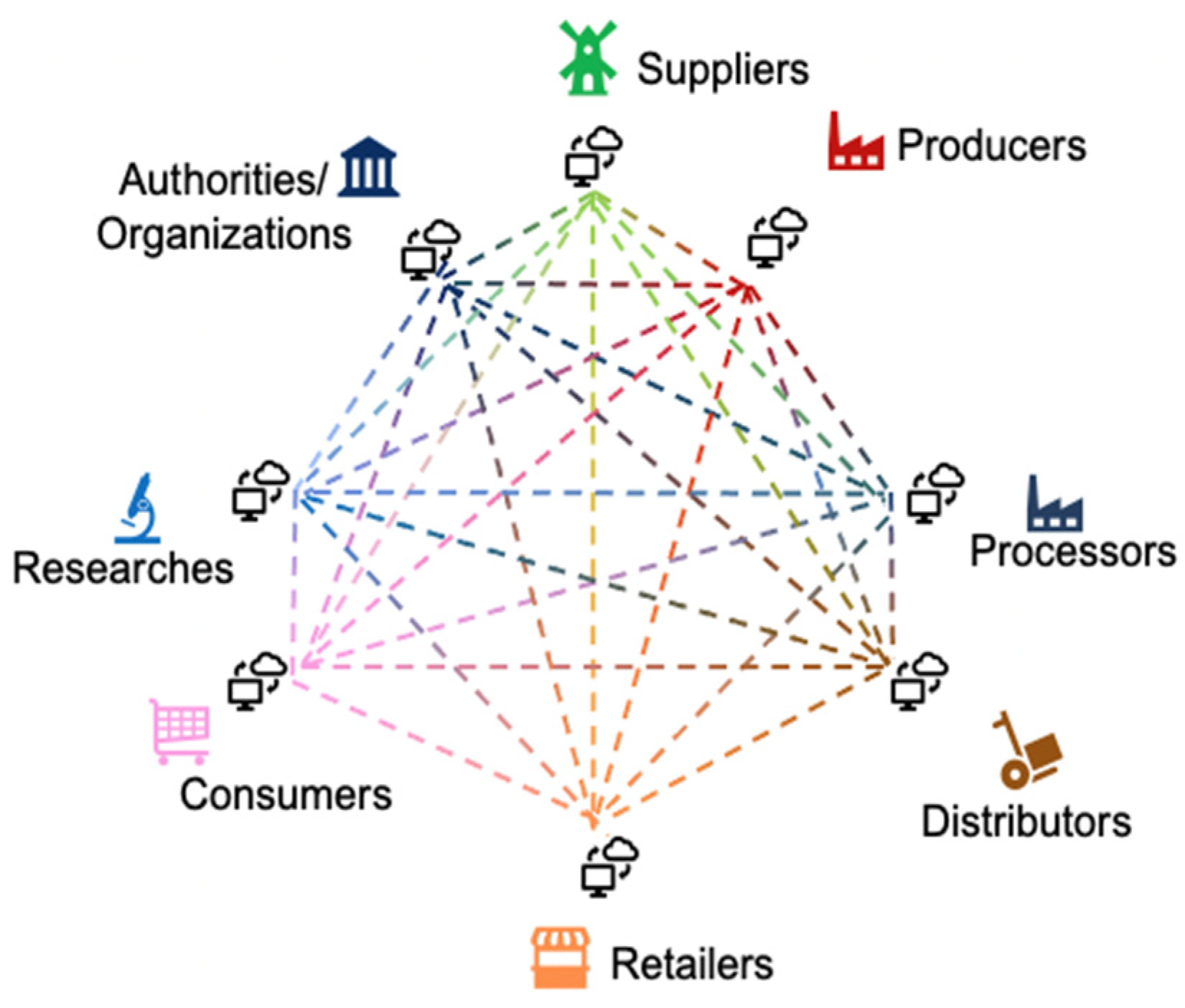
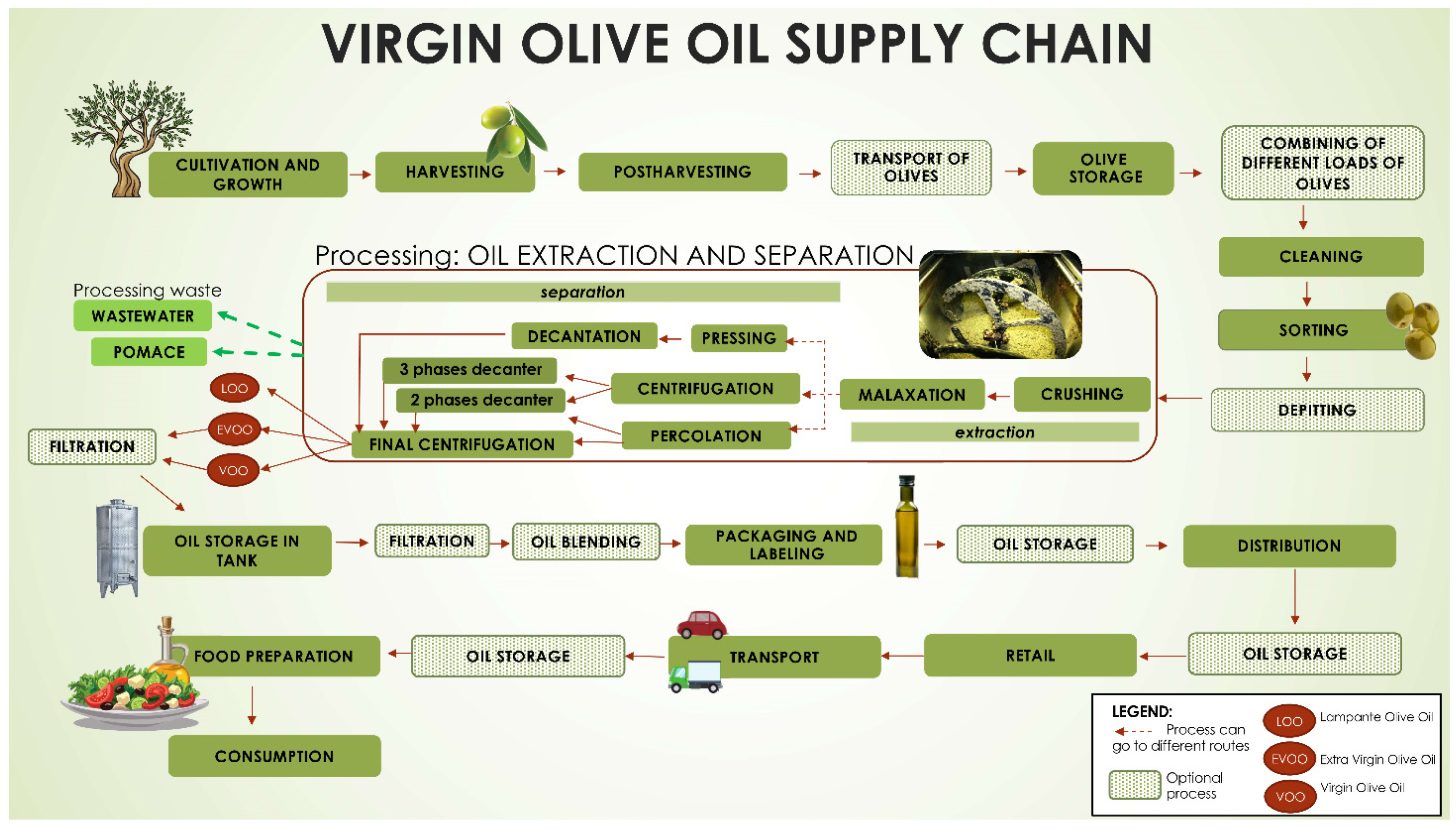
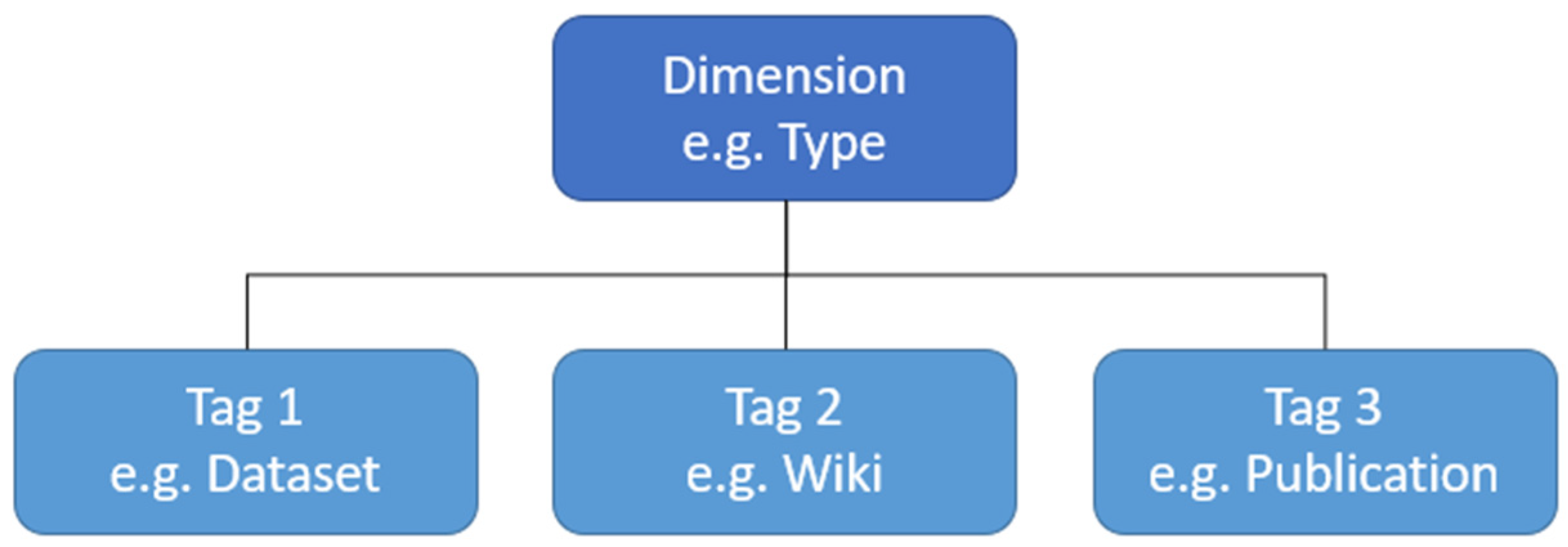
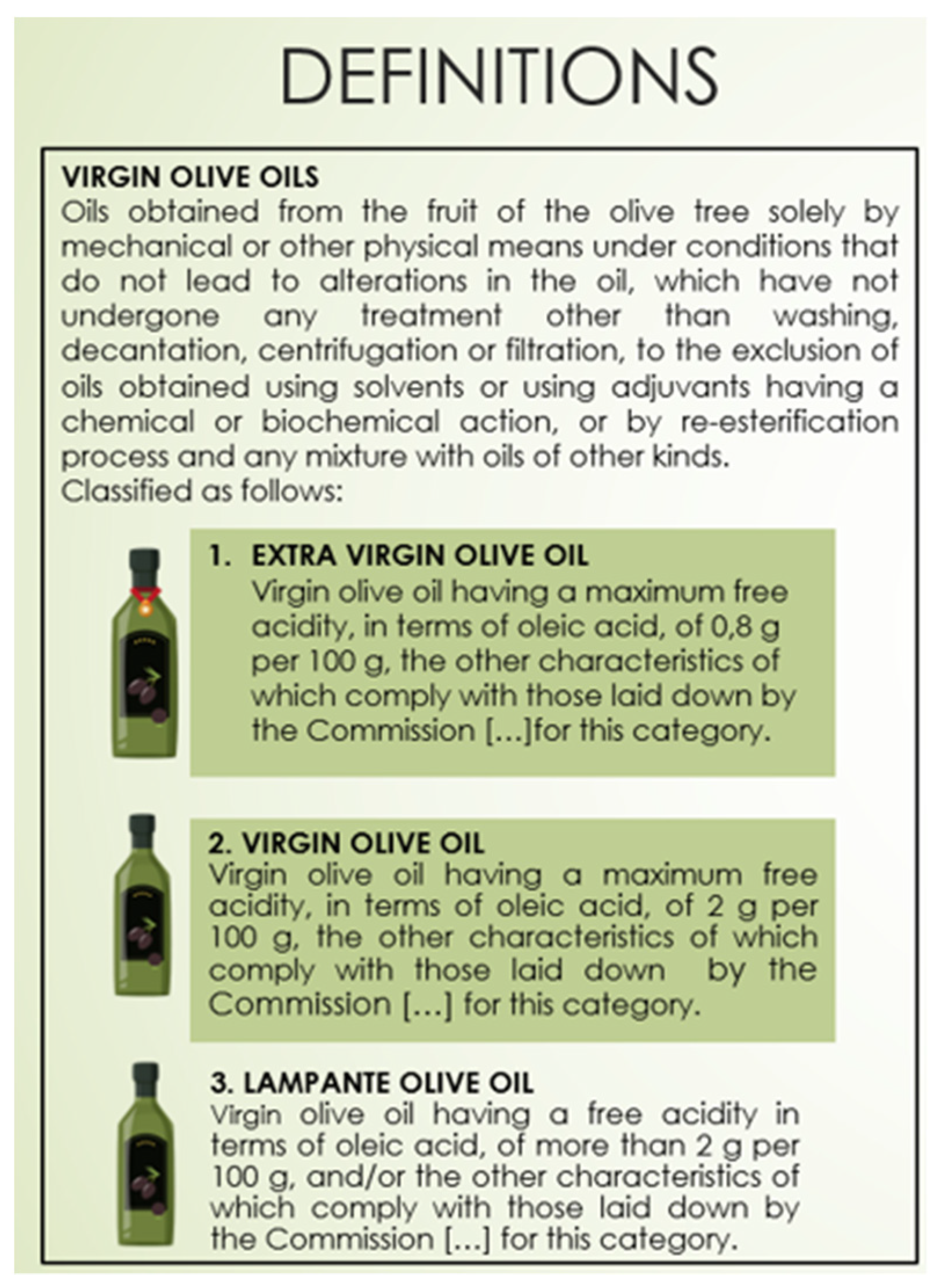
| Step | Definition | Input | Output |
|---|---|---|---|
| Cultivation and Growth | All stages that concern agronomic practices to make olives grow and keep them healthy until harvest | Olive Trees | Olives |
| Harvesting | The process of gathering a ripe crop from olives fields. It can be done after natural fall, by hand, by beating the branches, with shakers, by combing (previously is commonly used to put canvases on the soil for the reception of the harvested fruits) | Olives | Olives |
| Postharvesting | Olives are taken from the nets on the ground and put into bins | Olives | Olives |
| Transport of Olives | Olives are transported to oil mill by olive grower | Olives | Olives |
| Olive Storage | Olives are stored in rigid and ventilated containers in a cool and dry environment | Olives | Olives |
| Combining Different Loads of Olives | Olives can arrive from different olive’s growers and are mixed together | Olives | Olives |
| Cleaning | Involves defoliation and washing | Olives | Olives |
| Sorting | Discarding any bruised or defective fruit | Olives | Olives |
| Depitting | Separation of the pits from the olives | Olives | Olives |
| Nutritional Quality | Safety | Authenticity/Transparency | |||||
|---|---|---|---|---|---|---|---|
| Phase | Matrix | Parameters of Interest | Parameters of Influence | Parameters of Interest | Parameters of Influence | Parameters of Interest | Parameters of Influence |
| Cultivation and Growth | Olives | fatty acids (FFAs, SFAs, MUFAs and PUFAs), total polyphenols, tocopherol, secoiridoids (oleuropein, hydroxytyrosol), phytosterols, pigments (carotenoids, chlorophylls), lignans, secoiridoid derivatives, 3,4-DHPEA-AC, monoglycerides and peroxides, DAGs, peroxide value, pH, total CHO, soluble solids, % in oil | climatic and pedoclimatic conditions (e.g., air composition, sun exposure, physical-chemical characteristics of soil and trees, irrigation); type and fertilisers content; pruning, pest and disease management | toxic and potentially toxic elements, Polycyclic Aromatic Hydrocarbons (PAHs), mycotoxins, radionuclides | pedoclimatic conditions (e.g., physical-chemical characteristics of soil, environmental pollution) physiopatological factors, biocides and plant protection products (pesticides used) | isotopic ratios, rare earth elements, micronutrients, pigments profiles, genomic profiles | cultivar, latitude, longitude, rainfall, distance from sea, sun exposition, physical-chemical characteristics of soil, fertilisers use |
| Harvesting | time (t), techniques applied, maturity index, detachment index | foreign matters, texture, integrity | t, harvesting system, microbiological and biological contaminants | X | X | ||
| Postharvesting | Temperature (T), t, mechanical breakages, equipment | toxic and potentially toxic elements, free acidity, peroxide, K232 value, mold, insect and microbial infection, mold, FFA, peroxide value | aeration, equipment and storage conditions (T, t), mechanical breakages, handling, foreign materials | ||||
| Transport of Olives | |||||||
| Olives Storage | micronutrients content, free acidity level, peroxide, K232 value, K270 value, mold | storage conditions (T, t), processing equipment (e.g., tanks, pipes, drums, etc.) | |||||
| Arrival at the Mill | air humidity, free acidity | storage conditions (T, t) | |||||
| Combining Different Loads of Olives | micronutrients, total polyphenols, secoiridoids (oleuropein, hydroxytyrosol) phytosterols, pigments (e.g., carotenoids) | mixing ratio, content in each single load of olives | chemical residues | mixing ratio, content in each single load of olives | isotopic ratios, rare earth elements, micronutrients, pigments profiles, genomic profiles | olives loads provenance, cultivar, latitude, longitude, rainfall, distance from sea, sun exposition, physical-chemical characteristics of soil, fertilisers use | |
| Cleaning | total polyphenols | T, t, washing water quality | toxic and potentially toxic elements, foreign matters, pesticides | T, t, washing water quality | X | X | |
| Sorting | olive texture | X | olives texture | X | |||
| Depitting | pits, pit dust | machines efficiency | pit dust | pit hardness | |||
| Primary Production | Processing | Packaging | Storage and Distribution | Retail | Final Consumption | |
|---|---|---|---|---|---|---|
| Safety | TDS data (link) Medication concentration data (link) | |||||
| Nutritional quality | Possible contamination during olive oil extraction (link) | Loss of vitamins during storage (link) | Label information (link) | Greece food composition database (link) | ||
| Authenticity/transparency | Isotope data (link) |
Publisher’s Note: MDPI stays neutral with regard to jurisdictional claims in published maps and institutional affiliations. |
© 2022 by the authors. Licensee MDPI, Basel, Switzerland. This article is an open access article distributed under the terms and conditions of the Creative Commons Attribution (CC BY) license (https://creativecommons.org/licenses/by/4.0/).
Share and Cite
Palocci, C.; Presser, K.; Kabza, A.; Pucci, E.; Zoani, C. A Search Engine Concept to Improve Food Traceability and Transparency: Preliminary Results. Foods 2022, 11, 989. https://doi.org/10.3390/foods11070989
Palocci C, Presser K, Kabza A, Pucci E, Zoani C. A Search Engine Concept to Improve Food Traceability and Transparency: Preliminary Results. Foods. 2022; 11(7):989. https://doi.org/10.3390/foods11070989
Chicago/Turabian StylePalocci, Caterina, Karl Presser, Agnieszka Kabza, Emilia Pucci, and Claudia Zoani. 2022. "A Search Engine Concept to Improve Food Traceability and Transparency: Preliminary Results" Foods 11, no. 7: 989. https://doi.org/10.3390/foods11070989
APA StylePalocci, C., Presser, K., Kabza, A., Pucci, E., & Zoani, C. (2022). A Search Engine Concept to Improve Food Traceability and Transparency: Preliminary Results. Foods, 11(7), 989. https://doi.org/10.3390/foods11070989








